BANGLADESH
Rebuilding Democracy
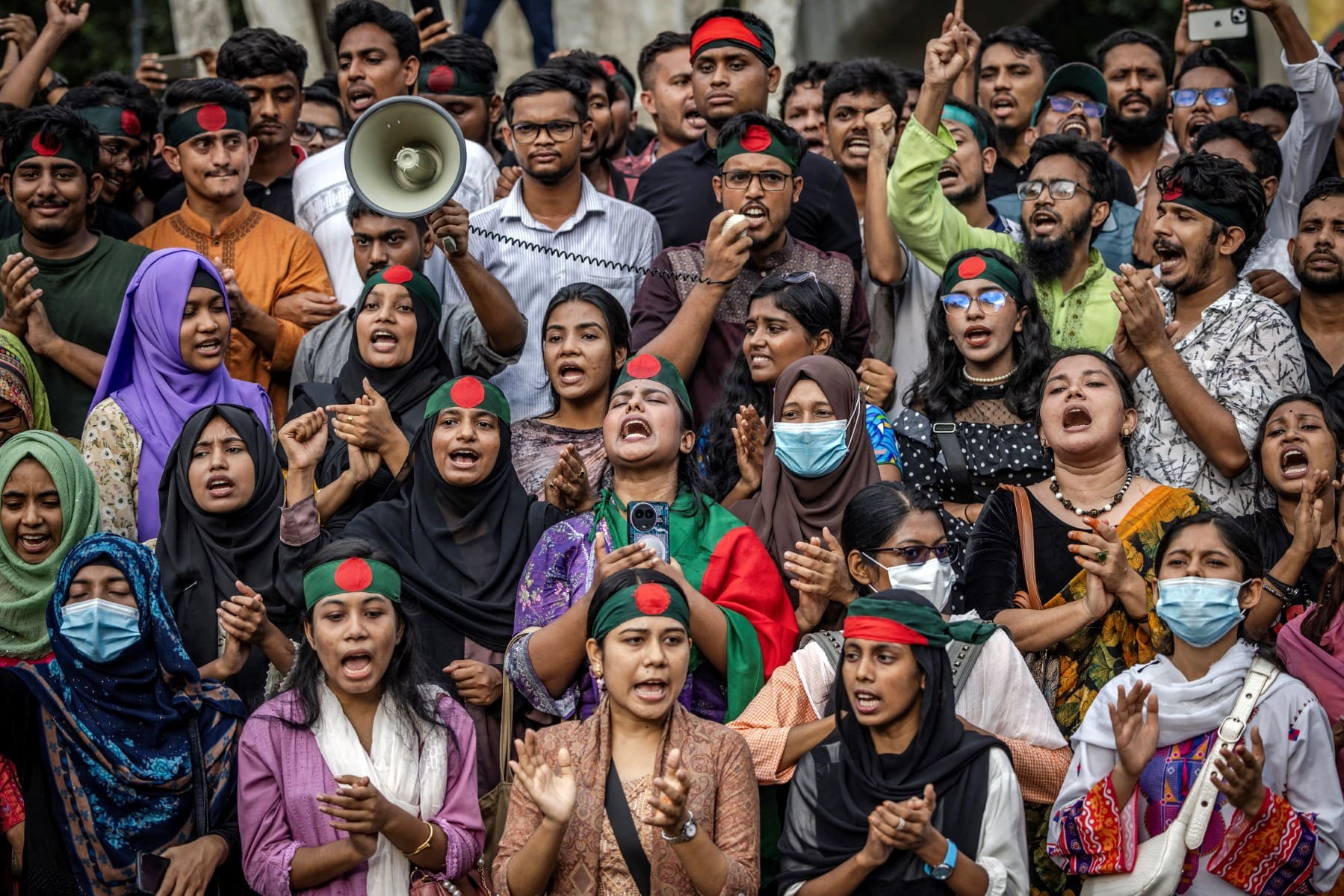
Under Hasina’s authoritarian regime, press freedom and democracy in Bangladesh significantly declined, until the popular student uprising of 2024 changed history in the country. Students protest to demand accountability and a trial against Hasina near Dhaka University on August 12, 2024. Credit: Luis Tato / AFP
The August 2024 ouster of authoritarian Prime Minister Sheikh Hasina through a popular movement heralded a new era of political freedom, press freedom and freedom of expression in Bangladesh – a country that carries a long legacy of struggle for democracy, freedom and human rights.
As the incumbent interim administration headed by Nobel laureate Muhammad Yunus began to initiate massive reforms to rebuild broken state institutions in the wake of the 2024 uprising, hopes ran high that press freedom and free speech – severely curtailed during Hasina’s iron-fisted rule of 15 years – would again be restored along with all other democratic rights.
Hasina’s seizure of the state apparatus and manipulation of the electoral process in uncontested, sham elections in early 2024 would not have been possible without her control over the media and digital space. Hundreds of journalists and critics fell victim to the strategy of restricting press freedom and muzzling dissenting voices while establishing and fortifying the government’s narrative.
Culture of fear
During its long tenure, Hasina’s regime regularly employed extreme measures to control media reporting and journalists that tried to uncover uncomfortable truths, abuse of power, corruption, and rights violations by enforcing draconian laws. New laws were also formulated to tighten the hold over critical voices both online and offline, and intimidation, arrest and torture of journalists and other perceived dissidents became the norm. Amid this culture of fear, many media workers and journalists in Bangladesh ceased to take confrontational stands with the authorities or to speak truth to power, and instead increasingly appeared to politically align with the government.
The gagging of Bangladesh’s media reached a peak in the year when Hasina’s government conducted ruthless crackdowns to quash the student-led mass uprising in July-August 2024. While the initial catalyst of the movement was the reinstatement of a civil service job quota for descendants of the 1971 Liberation War veterans, the protests were underpinned by broader dissatisfaction with a regime seen as increasingly authoritarian, corrupt and economically exclusionary.
Government figures estimate the numbers killed amid the protests at around 834, yet data collated by the Anti-Discrimination Student Movement (a politically non-affiliated student platform that emerged in 2024) puts the figure of the dead at 1,581. Most were victims of shootings. During the protests, five journalists were killed and around 250 were injured.
To keep people in dark about its atrocities, the government also shut down the internet and blocked mobile networks. A report by the UN Human Rights Office (OHCHR) released on February 12, 2025, has also shed light on the systematic control and suppression of media during the mass protests, which prevented them from reporting fully and truthfully in the midst of the crisis.
When media outlets, particularly the country’s television channels, carried only official narratives, enraged protesters then began to target and vandalise several media houses and attack journalists. Some media, notably a few newspapers, broke the barrier of fear to expose the brutalities being exacted on the ground through comprehensive reporting and coverage of the unfolding events.
After the Awami League-led government collapsed and Hasina fled the country on August 5, 2024, the Anti-Discrimination Students Movement (a lead organisation of the uprising) proposed economist and Nobel laureate Muhammad Yunus as the candidate to lead an interim government. Yunus accepted the proposal, and the interim government was finalised on August 7. This new caretaker government under the globally respected microfinance pioneer, promised to uphold press freedom even as the administration manoeuvred crucial reforms and democratic transition. Importantly, this promise immediately offered the media an opportunity to do journalism freely. But the reality on the ground didn’t prove true, with the subsequent arrests and lawsuits made against journalists on vague charges, revocation of press credentials, capture of media institutions and continuing attacks on journalists. This situation, along with new forms of intimidation from political groups and emboldened Islamists, has posed fresh challenges to press freedom in Bangladesh.
Media Rights Violations
Killings
Arrests
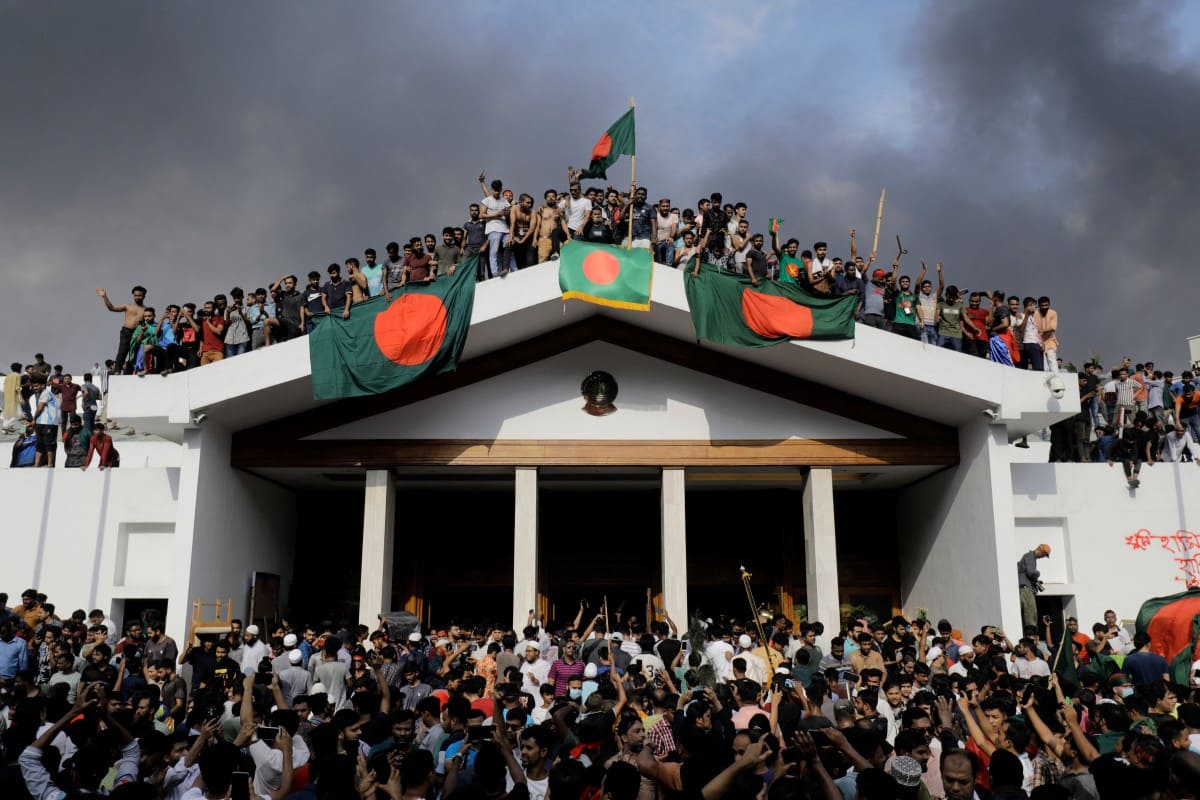
Sheikh Hasina’s government systematically controlled and suppressed media during the 2024 nationwide mass protests, preventing them from reporting fully and truthfully. Anti-government protesters display Bangladesh’s national flag as they storm Prime Minister Sheikh Hasina’s palace in Dhaka, Bangladesh, on August 5, 2024. Credit: K.M. Asad / AFP
Shifting allegiances
Zayadul Ahsan Pintu, the editor of DBC News, was “relieved of his duties” to make way for Loton Ekram, while Rahul Raha, executive editor of News 24, was forced to step down and was replaced by Farhadul Islam Farid.This reshuffle was a result of mounting pressure from the conveners of the Anti-Discrimination Student Movement and the opposition BNP-Jamaat-e-Islami camps to dismiss journalists who were alleged to be supportive of the previous Awami League government. The journalists who lost their jobs included five women.
Journalists taking over the leadership of the news outlets were generally affiliated – directly or indirectly – with the BNP and Jamaat, a leaning that is already promoting partisan, biased reporting, thus further eroding public trust in the media.
Major changes occurred in the television industry where journalists loyal to BNP and Jamaat raced to get the top positions in as many channels as possible. In the time since, they have been able to take control of half of the 35 private and state-owned channels that are now in operation in the country. A similar situation also unfolded in the 11 national dailies and two online news portals. For example, the East West Media group, the most powerful media house with seven media outlets, is now controlled by a journalist actively involved with BNP politics. Soon after, editors of two newspapers, one television channel and one online news portal were replaced by journalists aligned with his party.
Another major shakeup took place at Ekattor TV channel when a journalist closely associated with the BNP leadership took control of the private channel following the arrest of its three top journalists. He went on to fire half a dozen senior journalists from the channel.
In another concerning development, BNP-affiliated journalists have now also captured the National Press Club and dismissed elected representatives who were supportive of Awami League. Similar was the fate of many regional press clubs.
Trust in the media had already hit a record low in the country, due to the perceived political bias during the Hasina regime. The chance of regaining credibility with fair and objective reporting is a far greater challenge emerging from a decade and a half of the Hasina’s authoritarian government chokehold.
About 100 journalists and media workers, including those who had been holding top positions as editors, heads of news bureaus and chief news editors, were forced to resign or had their services terminated.
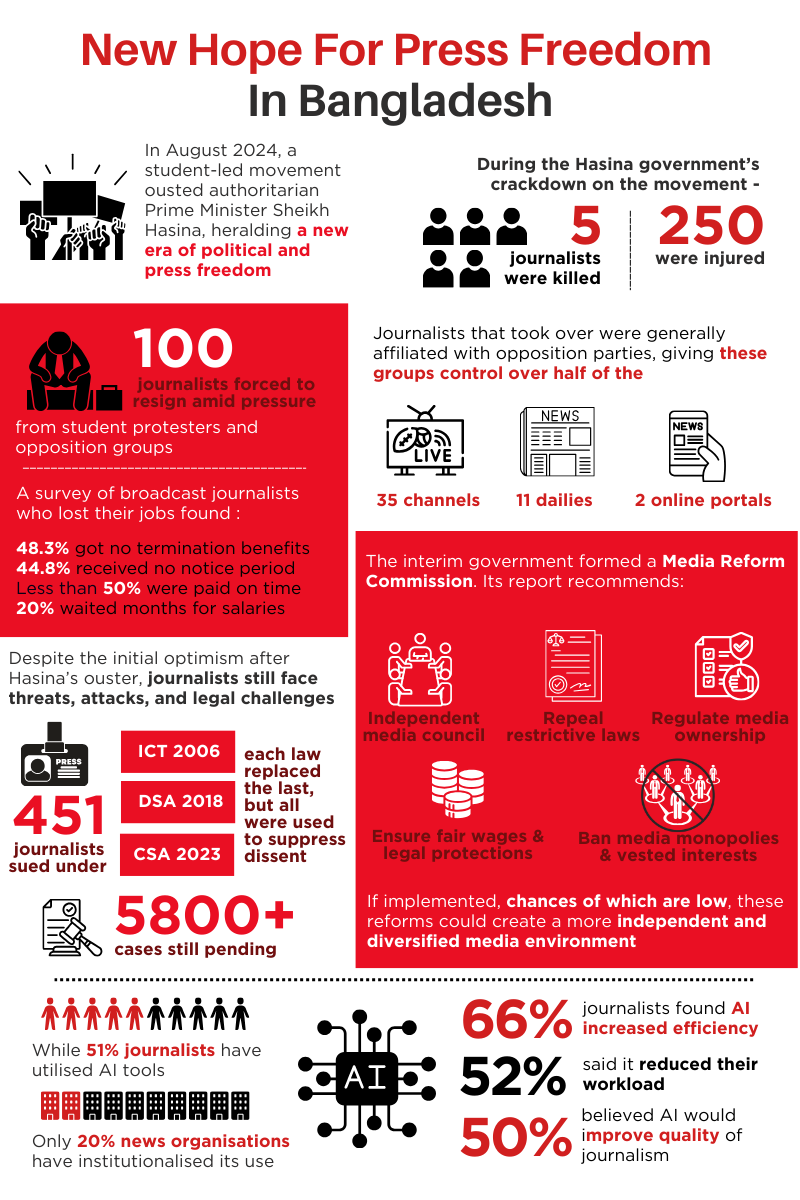
Intimidation and attack
The period since mid-July 2024, was particularly violent for journalists as they were regularly targeted, assaulted and threatened by different actors. Unfortunately, this has not changed under the interim administration.
As the protests raged, the number of casualties climbed by the day. A count by the Bangladesh Federal Union of Journalists (BFUJ) revealed that on July 23 alone at least 160 journalists were injured. Five days later, online news portal Bangla Tribune published a story, reporting that 226 journalists and media workers had been injured, 35 of them with bullets. By the end of 2024, the number of injured journalists was estimated at approximately 290.
Furious with media coverage, or the lack of it in some cases, demonstrators, police, politically affiliated student groups and goons attacked many journalists who had been reporting on the mass movement. Television reporters, photojournalists and videographers were particularly vulnerable. Many media workers were subjected to verbal abuse, equipment theft and car damage. Several television stations were also targeted and vandalised, disrupting broadcasts. Journalists, including women of these outlets faced harassment, creating a heightened climate of fear within the media community.
On August 14, a group of individuals affiliated with BNP stormed into the Chittagong Press Club in the eponymous southeastern port city and assaulted journalists, leaving at least 20 injured. A day later, following the release of Jasimuddin Rahmani, the chief of banned Islamic outfit Ansarullah Bangla Team (ABT), his followers in the comment section of the news, made threats (now deleted) for attributing what they perceived to be a wrong designation for Rahmani. This prompted many editors to remove related news or modify headlines. On October 23, Jamaat’s student wing, Islami Chattra Shibir, filed a defamation lawsuit of USD 82 million against the editor and two reporters of Daily Sangbad following publication of a report.
In late 2024, Islamist groups gathered in front of the Dhaka offices of the Daily Star and Daily Prothom Alo, demanding that the publications be shut down for allegedly “harming Islamic values.” Such attacks persisted in Dhaka and other regions of the country, with a shocking increase in attacks in February and March 2025. On February 3, 2025, a mob of hospital staff attacked four journalists in the Shariatpur district for publishing stories about negligence in medical treatment. Two days later, several journalists were beaten by BNP supporters at Bangladesh’s High Court while covering the verdict in a case filed against a number of BNP men.
A suspended police officer, accused of assaulting his wife, attacked journalists on the premises of Natore district court on March 11, leaving four journalists injured. Earlier, on February 12, hundreds of people identifying themselves as employees of Pacific Casuals Limited attempted to storm the offices of the newspaper Chattogram Pratidin, demanding removal of an article criticising their factory.
These attacks on media and media houses underscore the growing risks that journalists face in Bangladesh, particularly those reporting on corruption, violence, drug trafficking and malpractices of powerful persons or groups.
State agencies too unleashed violence on journalists. In February 2025, riot police beat six journalists with batons, punched and kicked them as they endeavoured to cover a student protest in Dhaka.
Ain O Salish Kendra, a non-government national legal aid and human rights organisation monitoring incidents of human rights violations, reported 487 cases of various types of attacks on journalists from May 2024 to February 2025. An additional 22 attacks took place in the first 20 days of March, according to media reports.
The tendency of political parties such as BNP and Jamaat, Islamists and local miscreants to target journalists spiked in the year, particularly in areas outside Dhaka. According to media reports, a total of 99 journalists were injured in 51 incidents through to March 20, 2025, with 47 of the attacks occurring outside of Dhaka. Among the political parties, BNP was noted as the top attacker with its members involved in eight attacks this year, compared to only two in 2024.
International organisations expressed concern over the surge in violence against journalists in the period and called upon the authorities to ensure safety of journalists. Bangladeshi Journalists in International Media (BJIM) also condemned the media attacks, asking the interim government to take stronger measures to safeguard journalists.
State controls
When Sheikh Hasina secured her fifth term through a sham election in January 2024, it seemed like more restrictions were in store for Bangladesh’s media. Already there were multi-pronged restrictions as part of which state agencies, both civil and military, monitored media around the clock. Content unacceptable to the government, the ruling party, or the former prime minister’s family never escaped their eyes.
Throughout her tenure, Hasina herself made intimidatory statements towards press, sending a clear message to the journalist community about what kind of journalism she wished to see. At press conferences, she routinely humiliated journalists for asking critical questions, seemingly wanting only ‘praise conferences’. On some occasions, journalists’ access to these press conferences was curtailed after asking critical questions, while the press wing representatives clearly briefed journalists to ask only positive questions. These actions collectively help foster a climate of fear and self-censorship among media professionals, thereby undermining independent journalism in the country.
Editors and newsroom leaders got used to receiving calls from different ministries, the Prime Minister’s Office, ruling party leaders and other influential persons to either remove certain content or publish reports of their choice and to entertain them such incursions. For them, a call from the Directorate General of Forces Intelligence (DGFI), which enjoyed a free reign under Hasina, was a frightening prospect. Many editors complained of getting phone calls – even at the dead of night – to kill certain stories or be summoned to the office of the agency.
The Office of the Human Rights Commissioner (OHCHR) report published in February 2025, explicitly narrated how state intelligence agencies and security forces intimidated journalists for a media blackout, by not reporting fully and truthfully about the brutalities on the demonstrators of the July-August 2024 movement.
“Ministry of Information officials and DGFI and National Security Intelligence (NSI) agents, including senior officials from the Ministry and DGFI, intimidated editors and journalists by calling them, coming to their offices and private homes and demanding changes to their reporting and broadcasting,” said the report.
It also reported that officers of para-military Rapid Action Battalion (RAB) raided a media outlet, assaulted employees and tried to force them at gunpoint to identify a journalist who had obtained information exposing serious violations by military officers. Officials of different agencies also intimidated victims, their families and lawyers and called up journalists with threats to ensure silence.
In an effort to stop the circulation of news of the government’s brutal crackdowns on social media, the Hasina government shut down the country’s internet on July 18, blocking major social media platforms and communication apps. The ousted regime continued its predatory tactics to tightly control the media until its last day in office.
Following the political transition, state restrictions have largely gone, but not entirely stopped with Muhammad Yunus’ press wing members and some of his assistants still often contesting critical stories, which many journalists claim limits press freedom.
In an effort to stop the circulation of news of the government’s brutal crackdowns on social media, the Hasina government shut down the country’s internet on July 18, blocking major social media platforms and communication apps.
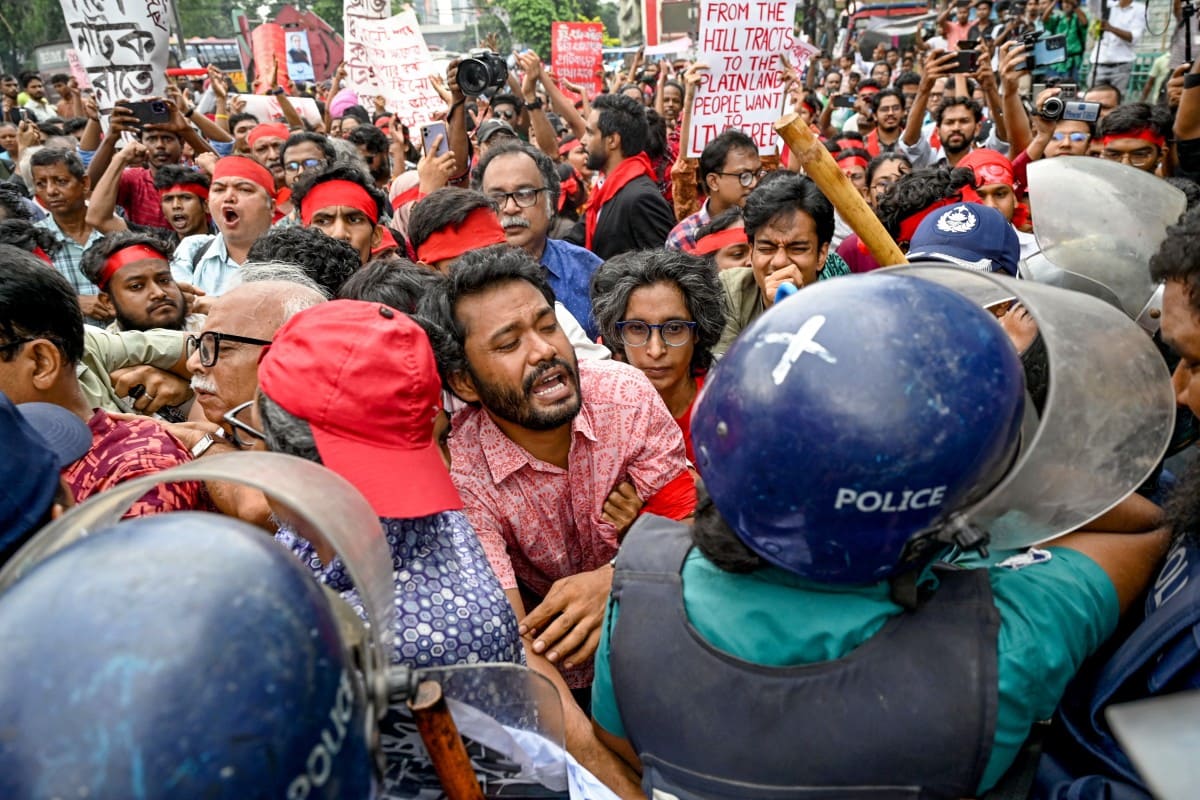
Five journalists were killed and around 250 were injured during the nationwide protests. Cultural activists and members of civil society clash with police personnel in Dhaka during a song march for victims who were killed during the protests on July 30, 2024. Credit: Munir Uz Zaman / AFP
Deadly job
The period under review has been deadly for journalists in Bangladesh. Seven media workers were brutally killed and one journalist found dead in less than three months, from mid-July to October 12, 2024.
Four journalists were shot dead by security forces while one was hacked to death by anti-government protesters in the three weeks of the mass uprising, all in the line of their professional duties.
Hasan Mehedi, a reporter for news portal Dhaka Times was shot in the head while covering clashes in the Jatrabari area of Bangladesh’s capital, Dhaka. Shakil Hossen, a correspondent for Daily Bhorer Awaj, died in a similar fashion while reporting in Gazipur, near Dhaka, on July 18. The following day, Abu Taher Md Turab, a reporter for Daily Jalalabad and Daily Naya Diganta, was fatally injured from police bullets while reporting the movement in the southeastern city of Sylhet. His colleagues confirmed that Turab was wearing a press vest that was clearly visible when he was shot.
On August 2, Tahir Zaman Priyo, a former videographer for The Report 24 was also shot dead in Dhaka by security forces. On August 5, senior journalist Pradeep Kumar Bowmik, of Daily Khabarpatra, was killed inside the press club of northern Sirajganj district. His colleagues said that anti-government agitators clashing with police hacked him to death.
Veteran journalist Swapan Kumar Bhadra was hacked to death outside his home in Mymensingh district on October 12. He was a former vice-president of local press club and had previously worked for the newspaper Dainik Swajan. He was known for being active on social media, where he frequently addressed issues such as terrorism, drug trafficking, and other local concerns. Media reports indicated that an addict, against whom the journalist wrote on social media, attacked him with a knife.
Behind bars
Within weeks of Hasina’s fall, five journalists, including a female were arrested on charges of murder and crimes against humanity, while at least 140 others faced similar kind of charges, in apparent political reprisals.
Four of the arrested journalists were from private channel Ekattor TV, including the managing director and editor-in-chief, Mozammel Haque Babu; chief correspondent Farzana Shakil; her husband and head of news, Shakil Ahmed; and senior reporter Mahbubur Rahman. They remain in jail. The other jailed journalist is the editor of the Bangla daily Bhorer Kagoj, Shyamol Datta. Dutta was general secretary of the National Press Club and Babu was holding the position as president of the Editors Guild. Local journalists’ and international organisations voiced significant concerns regarding the treatment of the journalists.
In September 2024, Bangladesh’s Editors Council said that murder cases were being indiscriminately filed against journalists, which constituted misuse of laws and violation of the interim government’s promise for free journalism.
On October 24, journalist Sheikh Jamal, who was also notably a leader of Sheikh Hasina’s party, was arrested from Dhaka on various charges. Following the fall of Hasina, he had been posting critical comments on social media supporting his party and opposing the interim government. He was released from jail after 97 days.
In March 2025, two more journalists were arrested from northern Natore and Pabna districts in a span of two days. Abdur Rashid, the Sinagra Upazila correspondent for Daily Samakal, was arrested in Natore after he submitted an application under the Right to Information Act requesting a district officer to provide information about Jal Mahal (water bodies). He was subsequently arrested in a raid as part of Operation Devil Hunt, an ongoing operation launched by the Yunus interim government since February 8, following protests over a violent attack on students and civilians in Gazipur on February 7. The arrest implicated him as an unidentified accused involved in the clash.
Protesting his arrest, over 100 journalists from the district began demonstrating in front of the offices of the district’s two top government officials, demanding his release and removal of those responsible for arresting him, which ultimately led to his release on bail.
Journalist Mobarak Biswas, a Pabna district correspondent of ATN Bangla television, was arrested at his home on charges of his alleged involvement in extortion. He is also facing several other criminal cases.
Within weeks of Hasina’s fall, five journalists, including a female were arrested on charges of murder and crimes against humanity, while at least 140 others faced similar kind of charges, in apparent political reprisals.
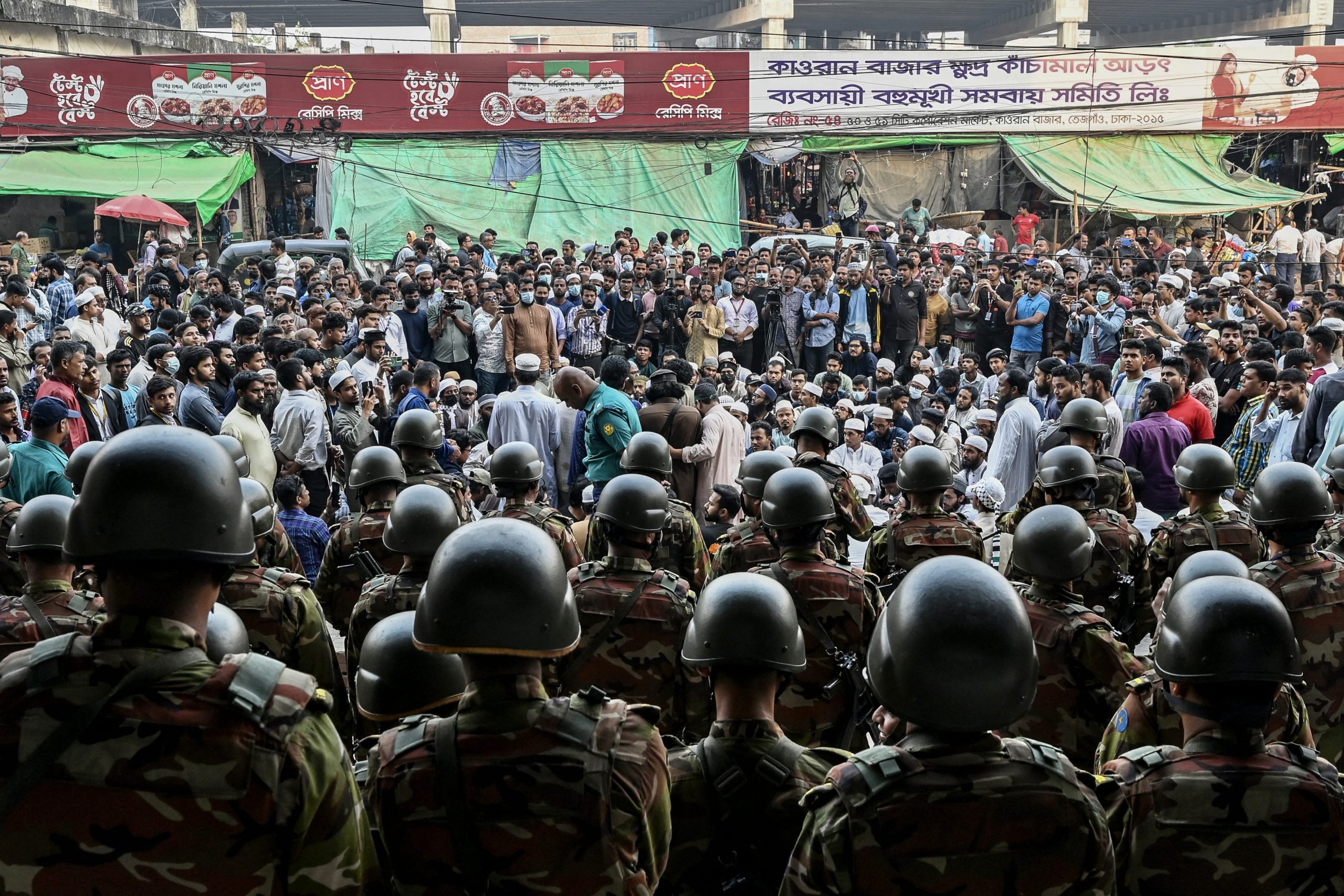
Bangladesh’s caretaker government promised to uphold press freedom, offering the media an opportunity to do journalism freely. But the reality on the ground didn’t prove true with arrests and lawsuits made against journalists, sackings, revocation of press credentials and attacks on media houses. Bangladesh Army personnel stand guard as protesters stage a demonstration in front of the Prothom Alo newspaper’s office in Dhaka on November 25, 2024. Credit: Munir Uz Zaman / AFP
No pay, low pay
Over the past 15 years, the number of media houses in Bangladesh has steadily increased, thus creating greater employment opportunities for media workers. Yet job security and pay are ensured only in a handful of media outlets, while journalists in most of Bangladesh’s media outlets work with little or irregular pay and vulnerable to lose their jobs at any time.
Job security and decent wages are not ensured even in the newly emerged media. There are many instances in which a newspaper or television channel begins with promising job security and pay, but later fires journalists after several years, an action that many media owners take at their will.
Uncertainty over jobs and pay have forced many Bangladeshi journalists to switch professions, while others made their way abroad. Many journalists are victims of sudden job loss or, those who have not been paid for months, regularly find themselves in dire economic hardship. While some find alternatives, the majority remain jobless. For women journalists, the situation is even harder, with many opting to return to being full time homemakers.
This situation took a grave turn after the political changeover, when around 100 journalists lost their jobs in an apparent act of political retribution due to a perceived proximity to the ousted regime. Most of these media workers did not get their dues and continue to remain jobless.
A survey conducted by the Broadcast Journalists Centre on 30 television channels revealed a frustrating picture of pay and job security in Bangladesh. Released in December 2024, it found that more than 150 broadcast journalists lost their jobs through 2024, mostly after Hasina’s ouster. The number of journalists would be much higher if rural journalists were taken into consideration in the survey.
Survey findings revealed that 48 per cent of television channels did not provide termination benefits, while 45 per cent did not give a notice period for termination of services, both of which are mandatory by the law. Less than half of the channels paid their workers on time, while 20 per cent kept their workers waiting for several months for salaries.
Moreover, only a few channels provide health insurance; 90 per cent did not have regular annual increments, and 72 per cent of workers did not get paid for overtime. Since the uprising, two television stations and one Bangla daily have been shut down, leaving hundreds of journalists and media workers jobless.
Although Bangladesh’s media sector is run by rich businesspeople and politicians, economic challenges remain. Too many journalists perform their duties with multiple risks, particularly when covering violence and lacking protective gear such a bullet-proof jackets or protective helmets.
Evolving media
With media freedom severely curtailed and mainstream media outlets largely staying away from critical reporting, independent voices and alternative media platforms have gained prominence and traction in Bangladesh.
These new players include digital news platforms, social media influencers, YouTubers and fact-checkers that have challenged government narratives that mainstream media failed to do. With it, they are also known to advocate for press freedom in Bangladesh. In their reporting, they have sought to expose corruption, abuse of power and human rights violations, including enforced disappearances and extrajudicial killings that largely remained missing from mainstream media. Such reporting gained popularity and credibility among readers and viewers in Bangladesh.
Prominent among these new players is Netra News, a Sweden-based independent platform founded by a Bangladeshi journalist in exile. In 2022, its investigations exposed security forces’ secret prisons where abducted persons were confined and tortured. After the fall of Hasina, the world came to learn that there were many such secret prisons in operation across the country. The platform also published some stories against the military intelligence agency DGFI and paramilitary force RAB that no local media could dare to do.
Zulkarnain Saer Khan, a London-based investigative journalist in exile, has also been instrumental in exposing abuse of power, rights violations and corruptions by leaders of Hasina’s party and civil and military officials associated with her government through his social media platforms. As a member of Al Jazeera’s investigative unit, he helped produce a documentary titled “All the Prime Minister’s Men” in 2021, exposing corruption and misuse of power of powerful military and political figures having links with the former prime minister. After the political shift, both Khan and Netra News continue to publish stories against powerful persons and groups.
Fact-checking organisations have also emerged as credible sources of information while some journalists, unable to work freely in mainstream media, have turned to YouTube and Facebook to air critical opinions but on a limited scale, fearing reprisal of the previous regime. Several YouTubers and social media influencers have successfully disclosed information that local media failed to do, drawing millions of followers.
Armed with smartphones, activists, journalists and even ordinary citizens now report live events, especially during political unrest, student movements or protests, bypassing the usual censorship and restrictions. Now, with censorship lifted, citizens can freely express opinions on social media platforms, which are encouraging more and more people, including journalists to open their own news portals and YouTube channels. In these spaces, there is a strong criticism of authorities, and it is noted that fierce debates on social media do not meet with immediate reprisal.
With media freedom severely curtailed and mainstream media outlets largely staying away from critical reporting, independent voices and alternative media platforms have gained prominence and traction in Bangladesh.
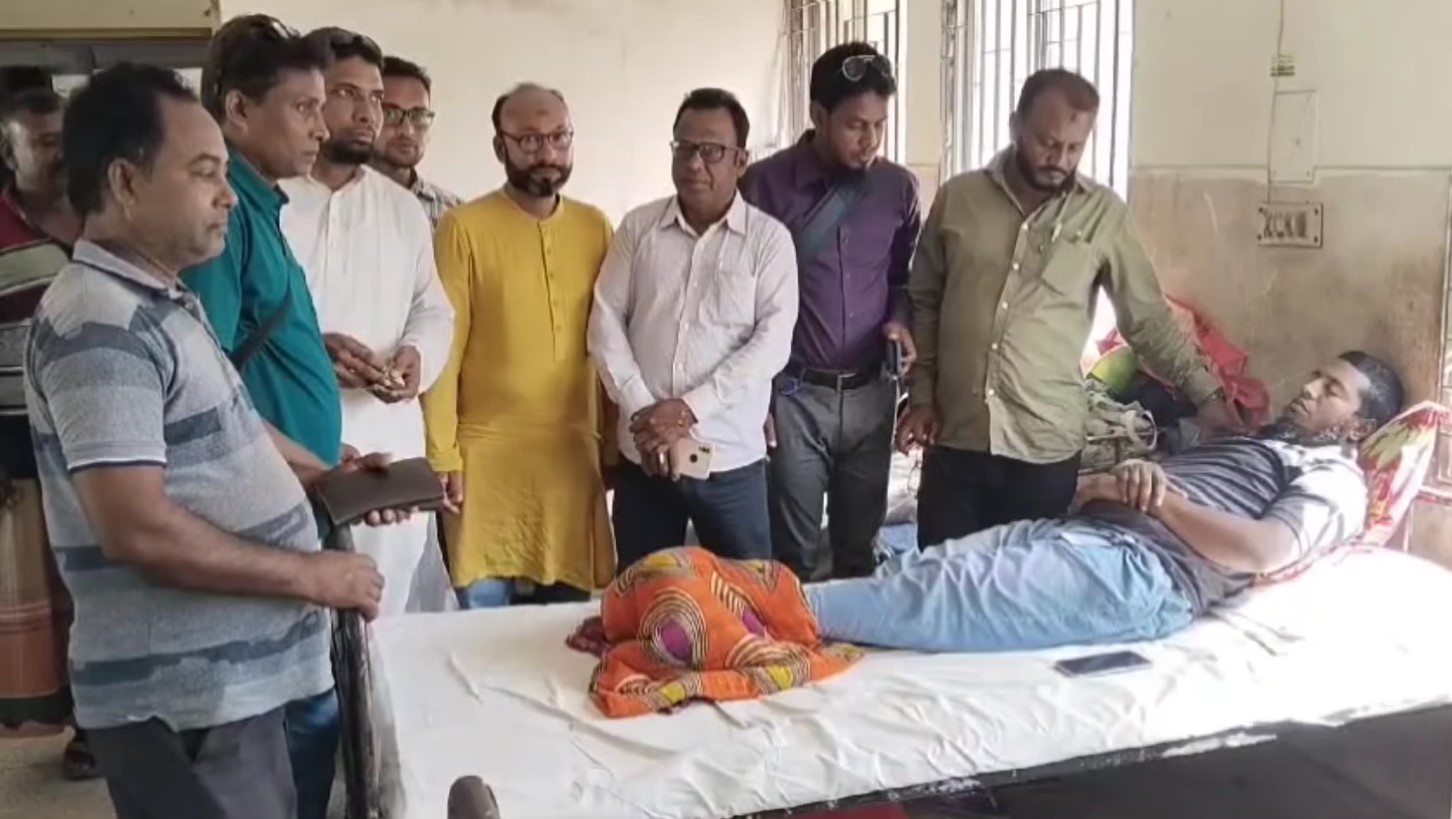
From July 2024, journalists were regularly targeted, assaulted and threatened by different actors. Unfortunately, this did not change under the interim administration. Journalists of the Rupsa Upazila Press Club visit News21 reporter Shahidul Islam in hospital, following mob attacks on November 8, 2024. Credit: Facebook.
AI in the newsroom
Artificial Intelligence (AI) is beginning to make its mark on Bangladesh’s journalism sector, offering both opportunities and challenges. While individual journalists are increasingly adopting AI tools, institutional integration remains limited but is gradually influencing the journalism landscape.
“Media Metamorphosis: AI and Bangladeshi Newsrooms 2024”, a study conducted by the Media Resources Development Initiative (MRDI) with support from Digitally Right found that while 51 per cent of journalists have utilised AI tools, only 20 per cent of news organisations have institutionalised its use. ChatGPT was the most popular tool, accounting for 78 per cent of all usage, followed by Grammarly (52 per cent), Google Translate (44 per cent) and Canva (37 per cent). The primary use of AI was to improve grammar and writing style, with a combined usage rate of 52 per cent, while journalists also used AI for content enhancement, fact-checking, conducting research and background verification.
About two-third of the journalists surveyed found that using AI has increased their efficiency and improved their content quality while 52 per cent reported that it reduced their workload. Half of the participants believed that AI would significantly improve the quality of journalism in the future.
However, limited technological infrastructure and a lack of training opportunities continues to pose challenges to the effective implementation of AI in Bangladesh’s journalism. Debates are ongoing in newsrooms about the positive and negative impacts of using AI where many also perceive it as a threat to creativity. Concerns also exist regarding the accuracy and reliability of AI-generated content.
What is clear is that the future impact of AI on the Bangladeshi journalism job market will largely depend on how news organisations adapt to these technological advancements and the extent to which they invest in training their staff to work alongside AI tools.
Elections, democracy and the media
Sadly, from 2009 onward, under Hasina’s authoritarian regime, press freedom and democracy in Bangladesh significantly declined – particularly from 2011, when her government abolished the caretaker system, which ensured fair elections. This allowed Hasina to influence the electoral process and secure uncontested victories in the years that followed.
When the main opposition boycotted the 2014 election, suspecting her aim of manipulating it, her party candidates were elected uncontested in more than half of the parliamentary constituencies to ensure she retained in power. The strong role that media played in the 2008 election was also absent in this election.
During the 2018 election, in which opposition candidates did contest, journalists uncovered widespread irregularities, including ballot stuffing at night, but many stayed silent out of fear of retaliation and retribution. The media’s role waned further in the intervening period, when it apparently became more subservient to the government, before the January 2024 elections, where access to information was again severely restricted.
The legal environment
The Information and Communication Technology (ICT) Act of 2006 has been used as a major weapon to arrest and imprison hundreds of Bangladeshi citizens, including journalists and bloggers, using the vague language and severe penalties of its Section 57 before it was replaced by a newly promulgated Digital Security Act (DSA) in 2018, in the walk of growing pressure on Hasina government.
The move was a public relations exercise with the most repressive provisions of the 2006 law kept in the DSA to continue the government’s repressive measures, despite repeated calls by the journalist community and national and international human and media rights bodies.
A research paper by the Centre for Governance Studies, released in April 2024, revealed that at least 451 journalists were sued under these acts since its inception and 255 of them were sued for journalistic reporting. Among the accused, 209 journalists were associated with national media outlets, while 197 were with regional media outlets, adding that 97 of the journalists were arrested.
A few months before the January 2024 election, amid criticism from journalists and rights defenders for carrying over repressive provisions from the old law, Hasina’s government passed the new Cyber Security Act or CSA to replace the DSA. Some 5,818 cases were filed under the CSA and the previous two laws have been pending in the country’s eight cyber tribunals, while 1,340 cases were filed over the expression of free speech on digital platforms, among which 279 cases are still pending.
Since the fall of the government, demands for repealing or amending controversial laws have been growing and the interim government has announced it will repeal the CSA.
In December 2024, it approved the draft Cyber Protection Ordinance, drawing flak as it also contained provisions similar to that of the CSA. Rights activists said the draft ordinance concerningly would limit free speech online and disregarded the right to freedom of expression as a universal right.
The draft ordinance also penalises “hurting religious sentiment” with a jail term of two years and a fine of BDT 10 lakh (USD 8,226). Both the CSA and DSA contain this provision, which can easily be misused. Citing the draft as “conflicting to basic human rights,” 100 distinguished citizens issued a joint statement in January 2025 with demands for it to be scrapped.
The existing and proposed Cyber Protection Ordinance, initiated by the interim government, continue to create a climate where free speech is curtailed, and press freedom is under threat. For Bangladesh to uphold its democratic values, it is essential to reform or repeal these restrictive laws to ensure media professionals can work without fear.
The existing and proposed Cyber Protection Ordinance, initiated by the interim government, continue to create a climate where free speech is curtailed, and press freedom is under threat.
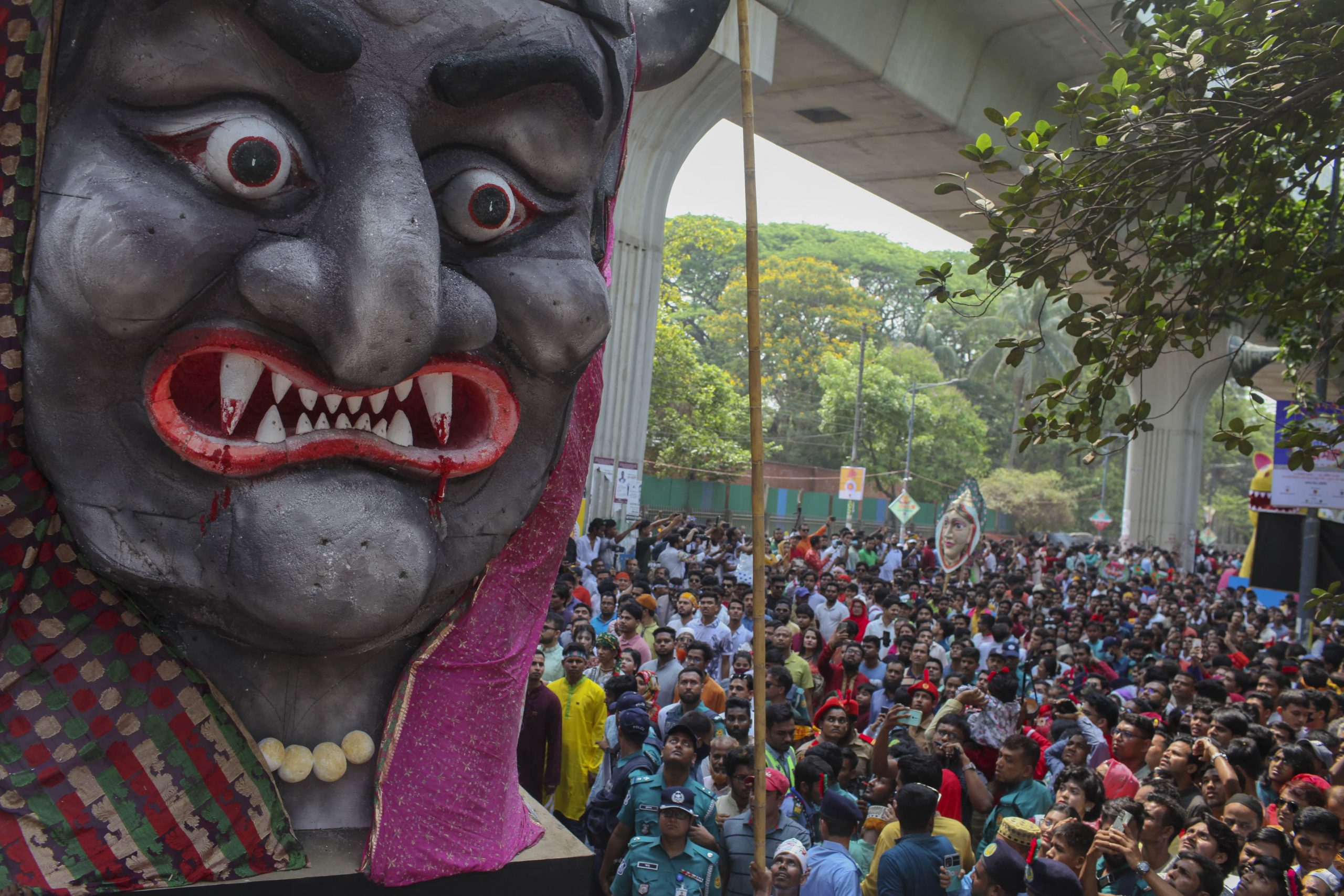
Despite the initial optimism following Sheikh Hasina ouster in 2024, the press freedom landscape remains in a complex and turbulent transition. Conveners of the Anti-Discrimination Student Movement have also been active in intimidating journalists. A motif of Sheikh Hasina appears in Mongol Shovajatra, the festivity of celebrating the Bangla New Year in Dhaka, Bangladesh, on April 14, 2025. Credit: MD Abu Sufian Jewel / NurPhoto via AFP
Crony media owners
Since 2009, many rich business leaders and politicians vied to obtain licenses for media outlets and were heftily rewarded so long as they met the condition that they remain loyal to the ruling Awami League.
By 2014, the country was home to many new media outlets, which included 24 private television channels, 23 FM radio stations, and 50 daily newspapers; all attributed to Hasina cronies. This trend continued until the fall of the government, with more cronies getting another 12 televisions channels and numerous other media outlets.
Many of these political and business moguls managed to have multiple media outlets, leaving the country’s media sector confined to a small group of operators and politicians whose alleged intention was to serve the public with journalism, yet only in reality served themselves and the government.
Thousands of aspiring and qualified journalists had no other way of doing their jobs independently, other than making the owners happy by ensuring their business and political interests. Some of the media owners are well known loan-defaulters, money-launderers and facing corruption allegations, while a few are accused of rape and murder charges. Yet none faced prosecution due to their proximity to the ruling party.
In one instance, the managing director of East West Media group walked free after being accused of the rape and murder of a teenage girl in 2021. The authorities failed to take any legal action against him. In another instance, a prime loan-defaulter, who owns two media outlets, was appointed adviser to the former prime minister.
What is clear is that this nexus nestled between the new owners and the government became a major barrier to independent journalism.
Long road ahead
The road traversed by the media in Bangladesh has not been easy. Since its independence in 1971, the country has been ruled mostly by army generals, as well as a military-backed caretaker administration and an authoritarian civilian government.
Press freedom had its first major blow in June 1975 when the country’s founding president shut down all but four newspapers through an executive order. Then the country fell into the grip of the successive military juntas which undermined both democracy and independent journalism for the next 15 years. When a mass upsurge deposed the country’s military ruler in 1991, democracy was again restored, and media began to thrive with independent and fearless reporting. This continued until a military-backed caretaker government took over in 2007.
Despite the initial optimism following the ouster of Sheikh Hasina in 2024, journalists continue to face threats, attacks, and legal challenges, putting freedom landscape in a complex and turbulent transition.
Conveners of the Anti-Discrimination Student Movement have also been particularly active in intimidating journalists, sometimes with outright threats. Hasnat Abdullah, the convenor-turned-top leader of the newly formed National Citizen Party (NCP) forced the owner of Somy TV to fire five journalists in December 2024. Then in February, he threatened to “break the pens” of journalists and commentators who wrote or spoke in favour of Hasina and her party.
Media heads are now increasingly complaining about direct interference of the leaders who marshalled the mass movement whenever a report goes against their interest and prompting media to take reports down or modify some. Media outlets were also forced to delete reports on the arrest of former Directorate General of Forces Intelligence (DGFI) boss following intervention by the agency in February, a clear indication that writing about the agency would be very difficult.
One editor expressed frustration over the new challenges journalism under the interim administration: “Media is now free to write against the deposed prime minister and her party. But before publishing a report, I think about it consequences. I just can’t publish anything against BNP, Jamaat, the new party of students, and the Islamists fearing reprisal. If I do, I will be tagged as a collaborator of previous government.”
This situation could change if the suggestions made by the Media Reform Commission are successfully executed. The interim government formed the commission with the objective of improving the professionalism, accountability and independence of the media sector.
The commission submitted its report to Yunus on February 22, 2025, proposing to establish an independent media council to oversee the media sector, repeal restrictive laws, regulate media ownership, ensure journalists’ proper wages and legal protections, and prohibit media monopolies and the use of media for vested interests.
If implemented, chances of which are low, these reforms could create a more independent and diversified media environment, raising Bangladesh’s standards of press freedom.
The interim government has promised fresh elections, to be held either at the end of 2025 or in early 2026, with hopes to restore democracy and press freedom. The path that Bangladesh will go will largely depend on the next government, a strong civil society and a vigilant, independent media.
Despite the initial optimism following the ouster of Sheikh Hasina in 2024, journalists continue to face threats, attacks, and legal challenges, putting freedom landscape in a complex and turbulent transition.
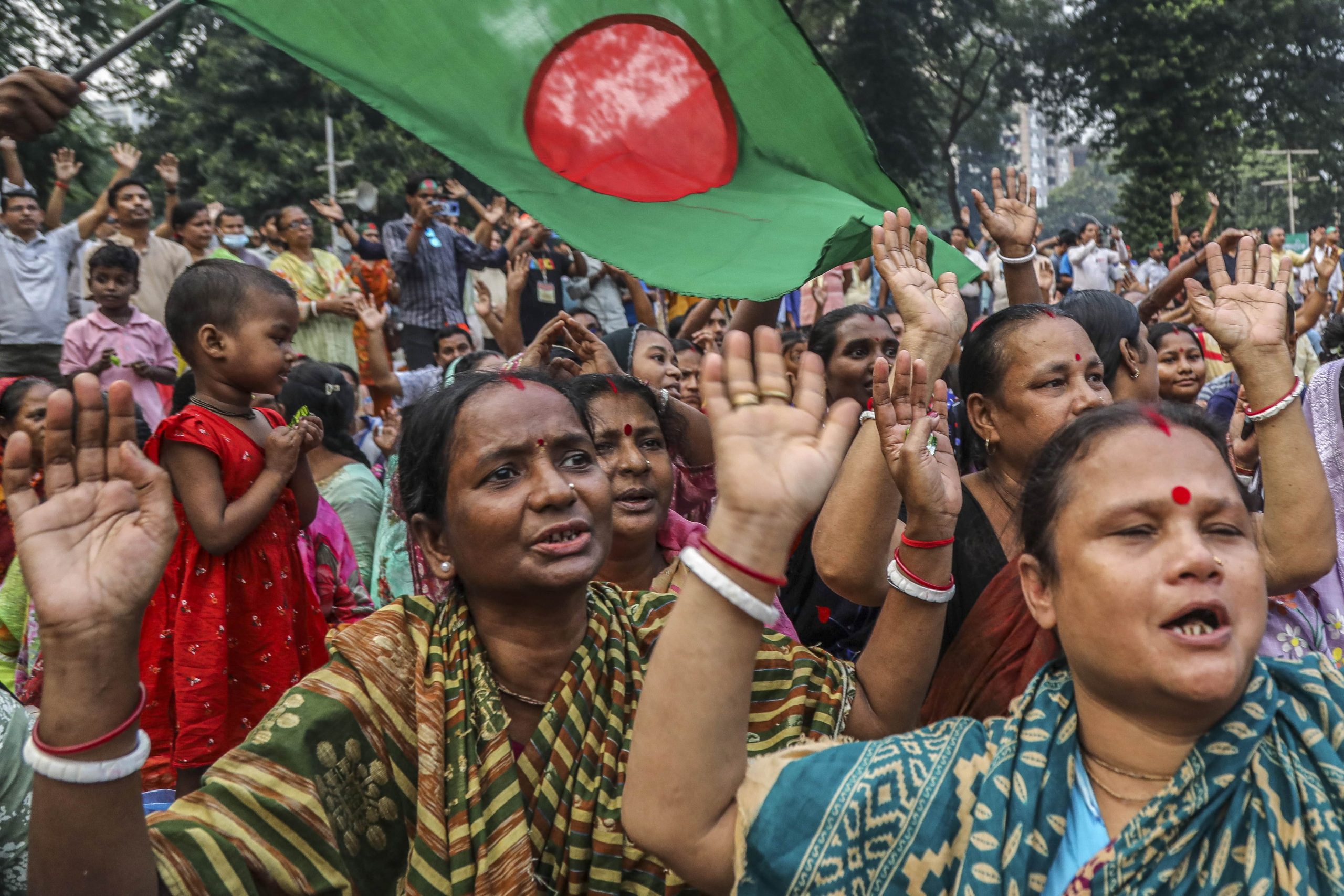
Disinformation and fake narratives did the disservice of discrediting genuine concerns of minorities in Bangladesh. People take part in a protest march demanding protections for Hindus and other minority groups after the expulsion of premier Sheikh Hasina, in Dhaka on November 2, 2024. Credit: Abdul Goni / AFP
Misinformation, the Media, and Minorities in Bangladesh
In the aftermath of the overthrow of Sheikh Hasina’s regime following a youth-led uprising in July 2024, the interim government faced several immediate challenges: restoring law and order; addressing economic concerns; countering emboldened religious zealots and ensuring a free media.
There were reports of looting and vandalisation of religious places, particularly temples and shrines, as well as attacks against Hindus who, at eight per cent, are the largest religious minority in Bangladesh. BBC Verify found exaggerated claims of ‘genocide’ against Hindus circulated through distorted videos on social media. A United Nations Human Rights Office (OHCHR) Fact-Finding Report, Human Rights Violations and Abuses related to the Protests of July and August 2024 in Bangladesh, found that the violence against the Hindus often involved property destruction, arson, and physical threats, compounded by insufficient police responses, suggesting systemic impunity and potential political motives. Across the border, a section of the pro-establishment Indian media also amplified disinformation on attacks on Hindus, and these reports in turn were amplified on social media.
Journalists from minority communities also reported being targeted through criminal charges, dismissals, financial restrictions, professional harassment, and even physical attacks. Some reported feeling so unsafe as to be forced to leave the country.
Amid the disinformation and breakdown of communication during the uprising, it was not easy to verify reports of violence that seemed to be a combination of political retribution, general lawlessness, and communal targeting.
According to an investigation conducted by the correspondents of prominent Bangla daily Prothom Alo across 64 districts between August 5 to 20, 2024, there were 1,068 attacks against minorities — mostly Hindus — in 49 districts. Other organisations put the figure at almost double that. Nine Hindus died during 2,010 incidents of communal violence in various districts between August 4 to 20, according to figures released by the Bangladesh Hindu Buddhist Christian Unity Council. However, an investigation by Bangladeshi media in exile, Netra News, debunked these figures. “Seven of the fatalities resulted from a mix of political retribution, mob violence, and criminal homicides. In some instances, the Unity Council’s assertions were undercut by the very news reports they cited and by their own grassroots officials,” said the report released on October 30, 2024.
However, misinformation was already being amplified. Between August 6 and October 12, 2024, there were over 11 million shares of the Bangladesh Hindu Buddhist Christian Unity Council’s statements on social media platform X according to a Netra News analysis.
As per data from the Dhaka Union of Journalists (DUJ), of the approximately 6,000 journalists in Dhaka, around 350 are from minority — mostly Hindu — backgrounds. Several Hindu journalists alleged harassment and being branded as “agents of India”. Some prominent journalists such as Munni Saha also faced public ire and her office was vandalised and looted. Often members of the Hindu community have been perceived as aligned with the ousted Awami League, which claims to be secular, in contrast with the opposition Bangladesh National Party, which until 2022 was a long-time political ally of the Islamist party Jamaat-e-Islaami.
A complaint was filed on August 29, 2024 with the investigation agency of the International Crimes Tribunal against 52 individuals, including former prime minister Sheikh Hasina. As many as 26 journalists, 10 of them from the Hindu community, were also charged with committing crimes against humanity and genocide during the anti-discrimination student movement.
The OHCHR report found “a broad pattern of violence against specific communities rooted in religious, ethnic, and political biases, with incidents clustering around themes of property destruction and the suppression of diverse identities. The power vacuum created by the unrest and overrunning of police stations led to increased vulnerabilities for distinct religious and indigenous groups, particularly Hindus, indigenous groups in the Chittagong Hill Tracts (CHT), and Ahmadiyya Muslims.” The report found that: “different and often intersecting motives drove these attacks, ranging from religious and ethnic discrimination to perceived opportunities for revenge against Awami League supporters among minorities, local communal disputes, including about land, and interpersonal issues.”
The OHCHR acknowledged that misinformation had clouded the understanding and context of several incidents, emphasising the importance of verified sources in reporting these events.
Diversity and inclusion
Disinformation and fake narratives do the disservice of discrediting genuine concerns of minorities in Bangladesh, where the official approach to indigenous and other minority communities reflects deep-rooted structural discrimination. The state has resisted recognising the approximately 45 ethnic groups as “indigenous”, instead terming them “ethnic minorities” in the dominant nationalist narrative. The media has played a crucial role in shaping public perception, often reinforcing negative stereotypes about indigenous people.
On January 15, 2025, at least 22 people were injured in Dhaka when an Islamist group attacked indigenous students protesting the removal of indigenous-themed artwork from school textbooks. DBC News journalist Jewel Marak, a member of an indigenous community, was hospitalised after the assault.
A September 9, 2024 report by the International Work Group for Indigenous Affairs noted that a crackdown displaced more than 4,000 Bawm, one of Bangladesh’s smallest indigenous groups, from their ancestral lands in the Chittagong Hill Tracts. At least ten civilians have been reportedly killed by the military since October 2022. On December 25, 2024, an alleged arson attack in Bandarban burned down 17 houses belonging to the Tripura community, leaving residents homeless and devastated during Christmas celebrations.
Protests followed the September 19 attack by illegal settlers — allegedly backed by Army personnel — which killed at least four people and left hundreds homeless in the Chittagong Hill Tracts. Army personnel reportedly confiscated and deleted footage from the cell phones of members of the indigenous community while assaulting them. Misinformation on social media further inflamed tensions against the Jummo community.
The Ahmadiyya Muslim community, estimated to number around 100,000 members, has long endured persecution and stigmatisation in Bangladesh. Mahmud Alam, one of only three known Ahmadiyya journalists in Dhaka, uses a pseudonym because disclosure would make it difficult for him to work as a journalist or even to survive.
Digital censorship, including the removal of live videos and cyber-attacks against bloggers, compounds these challenges and underscores the need for protecting indigenous identities. Public memory of the brutal public killings by Islamists of “atheist bloggers” across religious lines between the years of 2013 to 2015 is still fresh, a stark reminder of the cost of speaking out.
The change of regime in Dhaka presents an opportunity to foster a more inclusive media ecosystem, and to build robust filters for disinformation. Increased representation of minorities, training journalists on cultural sensitivity, establishing anti-stereotype guidelines, amplifying indigenous voices, and ensuring press freedom with media accountability could be important steps to combat past inequities.
